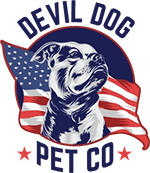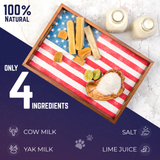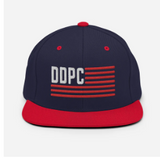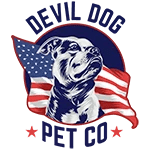Spotted a weird growth on your pup that looks like a tiny cauliflower? That's likely a dog wart—and before you panic, take a breath. These bumpy little hitchhikers are incredibly common, usually harmless, and often disappear on their own. But knowing what you're dealing with, when to worry, and how to help your four-legged battle buddy through it? That's where smart leadership kicks in.
Key Takeaways
- Dog warts often appear as small, cauliflower-like growths on your pet's skin.
- These warts are very common and typically harmless to dogs.
- Many dog warts will resolve on their own without treatment.
- Understanding when to be concerned and how to support your dog is important.
- Proper knowledge helps pet owners manage dog warts effectively and calmly.
Table of Contents
- Understanding Dog Warts: What You're Really Looking At
- What Causes Dog Warts to Develop
- Recognizing Dog Wart Symptoms and Their Impact
- Diagnosing Dog Warts: Getting the Right Answer
- Dog Wart Treatment: When to Act and How
- Managing Complications and Supporting Healing
- Long-Term Prevention and Immune Support
- Location-Specific Wart Considerations
- When Warts Signal Bigger Problems
- Monitoring Treatment Success and Resolution
Dog warts aren't the same as human warts, and they sure don't require the folk remedies your grandmother swore by. They're caused by canine papillomaviruses that target dogs specifically—meaning you won't catch them, but other dogs might. Most warts on dogs show up as raised, irregular growths that cluster around the mouth, paws, or eyelids, especially in young pups whose immune systems are still learning the ropes.
Here's the straight talk: while most dog warts resolve without intervention, some locations and circumstances demand action. A wart on dog paw pads can make walking painful. Warts on dog eyelids can interfere with vision. And when dog warts start bleeding from constant scratching or snagging, infection becomes a real concern.
Understanding Dog Warts: What You're Really Looking At
Let's get the terminology straight. When veterinarians talk about dog warts, they're referring to canine viral papillomatosis—benign skin growths triggered by various strains of canine papillomavirus. Think of these viruses as specialized troublemakers that have evolved specifically to mess with dog skin and mucous membranes.
The classic dog wart resembles a miniature head of cauliflower, with an irregular, bumpy surface that feels firm to the touch. But not all warts on dogs follow this playbook. Some appear as smooth, raised bumps. Others look like dark, scaly patches with rough edges. Inverted papillomas—a less common variant—present as firm lumps with a distinctive central dot, almost like a tiny volcano.
Size varies dramatically. You might find a single pea-sized bump or discover clusters of growths that span several centimeters. Color ranges from flesh-toned to dark brown or black, depending on the virus strain and your dog's pigmentation.
Where Dog Warts Love to Set Up Shop
Canine papillomaviruses are picky about real estate. Young dogs typically develop oral papillomas—warts that cluster around the mouth, lips, tongue, and throat. These oral invaders can make eating uncomfortable and sometimes cause persistent bad breath that no amount of dental chews seems to fix.
Adult dogs more commonly develop skin warts in areas prone to minor trauma or moisture. A wart on dog's foot, particularly between the toes or on paw pads, ranks high on the nuisance scale because constant pressure and friction keep these growths irritated. Dog warts on legs often appear where dogs scratch frequently or where leashes and collars create repeated contact.
The delicate skin around the eyes presents another prime target. Dog eyelid warts can interfere with normal blinking, cause excessive tearing, or create vision problems if they grow large enough. Similarly, dog warts in ear canals can trap moisture and debris, setting the stage for secondary bacterial infections.
What Causes Dog Warts to Develop

Canine papillomaviruses are the sole culprits behind every dog wart. These DNA viruses have co-evolved with dogs for millennia, developing sophisticated mechanisms to infiltrate skin cells and hijack their normal growth patterns. Once inside a cell, the virus commandeers the cellular machinery to produce more virus particles, causing the infected cells to multiply rapidly and form the characteristic warty growths.
Multiple virus strains exist, each with preferred target tissues. Canine papillomavirus type 1 (CPV-1) typically causes oral papillomas in young dogs, while other strains favor skin locations or specific breeds. This explains why some dogs develop mouth warts while others get skin growths—different viruses, different preferences.
How Dogs Actually Get Warts
The virus enters through microscopic breaks in skin or mucous membranes—tiny portals you'd never notice but that provide highway access for opportunistic pathogens. Normal puppy play creates countless micro-abrasions. Rough surfaces, thorny bushes, or even enthusiastic face-licking between dogs can create entry points.
Direct contact with infected dogs spreads the virus most efficiently, but that's not the only route. Canine papillomaviruses can survive on surfaces for weeks under the right conditions. Shared water bowls, toys, bedding, or grooming equipment in kennels, dog parks, or boarding facilities become virus reservoirs. Even well-meaning pet parents can inadvertently transport the virus on hands or clothing after petting an infected dog.
The incubation period typically runs 4-8 weeks from exposure to visible wart development, though it can stretch longer in dogs with robust immune systems that initially suppress viral replication.
Risk Factors That Stack the Deck
Age plays a huge role in wart susceptibility. Puppies and young adult dogs under two years old develop warts more frequently because their immune systems haven't encountered these viruses before. It's like the difference between a seasoned Marine and a fresh recruit—experience matters when facing familiar threats.
Certain breeds show increased vulnerability to canine papillomavirus infections. Shar-Peis, Cocker Spaniels, Miniature Schnauzers, Kerry Blue Terriers, and Pugs appear on most veterinary "high-risk" lists, though the genetic factors responsible remain unclear. Our dog Dexter never developed warts, but we've seen plenty of clients whose pups weren't as fortunate.
Immunosuppression creates perfect conditions for wart development and persistence. Dogs receiving corticosteroids, chemotherapy, or other immune-suppressing medications lose their natural ability to fight off viral infections. Chronic stress, poor nutrition, or underlying diseases like diabetes or Cushing's disease can similarly compromise immune function.
Recognizing Dog Wart Symptoms and Their Impact
Most dog warts start small and grow gradually over several weeks. Early lesions might be mistaken for insect bites or minor skin irritations, but their persistence and characteristic appearance soon reveal their true nature. What do dog warts look like as they mature? The classic cauliflower texture becomes more pronounced, and the surface develops a rough, almost scaly quality.
Black warts on dogs often alarm owners who worry about melanoma or other serious skin cancers. While any new growth warrants veterinary evaluation, dark coloration alone doesn't indicate malignancy. Many benign papillomas develop dark pigmentation, especially in breeds with naturally dark skin. To better understand the differences, you can refer to this comprehensive overview of dog wart types and causes.
When Dog Warts Cause Real Problems
Location determines impact more than size. A small wart on dog paw pad can cause significant lameness because every step applies pressure to the sensitive growth. Dogs may favor the affected foot, develop an altered gait, or resist walking on certain surfaces.
Oral warts create eating difficulties when they interfere with normal chewing or swallowing. Large growths on the tongue or throat can cause gagging, excessive drooling, or reluctance to eat hard kibble. Some dogs develop persistent bad breath as bacteria colonize the irregular wart surfaces. If your dog struggles with oral hygiene, consider introducing durable, long-lasting chews—see our yak cheese Himalayan dog chews for a tasty way to help support dental health.
Dog warts that bleed present the most immediate concern. Bleeding typically occurs when warts snag on objects, get scratched repeatedly, or experience trauma during normal activities. A bleeding dog wart creates an open wound that can become infected, especially in areas prone to contamination like paws or the mouth.
Crusty dog warts often indicate secondary bacterial infection or repeated trauma. The normal smooth or bumpy wart surface becomes covered with scabs, dried exudate, or thick crusts that may crack and bleed. These changes signal the need for veterinary intervention to prevent deeper infection.
How Warts Affect Your Dog's Behavior
Dogs rarely show obvious pain from uncomplicated warts, but discomfort manifests in subtle ways. A dog with painful paw warts might lick the area excessively, creating additional irritation and moisture that promotes bacterial growth. Facial warts can cause head shaking or pawing at the affected area.
Some dogs become self-conscious about their appearance—yes, dogs notice when they look different. While this might sound anthropomorphic, many owners report personality changes in dogs with prominent facial warts, including decreased social interaction or reluctance to engage in normal play behaviors.
Understanding these impacts helps you make informed decisions about treatment timing and approaches. Most dog warts resolve spontaneously within 6-8 weeks as the immune system mounts an effective response, but intervention may be warranted when warts significantly affect quality of life or create secondary complications.
The key to managing dog warts successfully lies in distinguishing between normal viral papillomas and more serious conditions, knowing when to wait versus when to act, and supporting your dog's natural immune response. In the next section, we'll dive deep into diagnostic approaches and explore the full spectrum of treatment options available to help your four-legged family member through this common but manageable condition.
Diagnosing Dog Warts: Getting the Right Answer
Most experienced veterinarians can spot a dog wart from across the exam room. The characteristic cauliflower texture, typical locations, and patient history usually paint a clear picture. But not every bump on your dog's skin is a simple papilloma, and distinguishing between benign warts and more serious conditions requires systematic evaluation.
Your vet will start with a thorough physical examination, paying close attention to the growth's size, shape, color, and texture. They'll note whether you're dealing with a single lesion or multiple warts, document exact locations, and assess how the growths interact with surrounding tissues. A wart on dog's eyelid that's causing irritation gets different consideration than a small bump on the leg that doesn't bother anyone.
Patient history matters enormously. Young dogs with multiple oral growths almost certainly have viral papillomatosis. Older dogs with solitary skin lesions require more careful evaluation to rule out other possibilities. Recent exposure to other dogs, boarding facility visits, or changes in the dog's environment provide valuable diagnostic clues.
When Simple Visual Diagnosis Isn't Enough
Atypical presentations demand additional investigation. Black warts on dogs that appear suddenly, grow rapidly, or have irregular borders might warrant biopsy to exclude melanoma or other skin cancers. Similarly, crusty dog warts that don't improve with basic treatment could indicate secondary bacterial infection requiring culture and sensitivity testing. For more details on when to seek veterinary help, check out this authoritative guide to dog wart healthcare.
Fine needle aspiration—inserting a small needle into the growth to collect cells for microscopic examination—helps differentiate warts from other soft tissue masses. This quick, minimally invasive procedure can usually be performed without sedation and provides immediate diagnostic information.
For definitive diagnosis, especially in cases where malignancy is suspected, surgical biopsy with histopathologic examination remains the gold standard. The pathologist examines tissue architecture and cellular characteristics to confirm papillomavirus infection and rule out other conditions that might mimic warts on dogs.
Dog Wart Treatment: When to Act and How

Here's where many pet owners get tripped up: the vast majority of dog warts require absolutely no treatment. Your dog's immune system, given time, will recognize the viral infection and mount an effective response that eliminates both the virus and the warts it created. This process typically takes 6-12 weeks from initial wart appearance to complete resolution.
But "wait and see" isn't always the right call. Certain situations demand intervention to prevent complications or improve your dog's quality of life. The decision to treat warts on dogs should be based on location, size, number, and functional impact rather than cosmetic concerns.
When Dog Warts Actually Need Treatment
A bleeding dog wart tops the priority list for intervention. Once the protective surface is compromised, bacteria can establish secondary infections that complicate healing and may require antibiotic therapy. Dog warts that bleed repeatedly from scratching or trauma won't heal properly until the underlying growth is addressed.
Location-specific problems warrant treatment regardless of wart size. A small wart on dog paw pad that causes limping needs attention. Dog warts on eyelid that interfere with normal blinking or cause excessive tearing should be removed. Oral warts that prevent normal eating or drinking require intervention to maintain proper nutrition.
Large numbers of warts—sometimes dozens or even hundreds in severely affected dogs—may overwhelm the immune system's ability to clear the infection naturally. These cases often benefit from treatment to reduce the viral load and help the immune system gain the upper hand.
Immunocompromised dogs represent a special category. Animals receiving corticosteroids, chemotherapy, or those with underlying immune-suppressing diseases may never clear papillomavirus infections without help. Early treatment prevents warts from becoming a chronic, progressive problem.
Surgical Removal: The Direct Approach
Surgical excision remains the most definitive treatment for problematic dog warts. Simple scalpel removal works well for accessible growths and provides tissue for histopathologic confirmation if needed. The procedure typically requires only local anesthesia for small, isolated warts.
Laser surgery offers advantages for multiple warts or those in sensitive locations. The precision of laser removal minimizes damage to surrounding healthy tissue, reduces bleeding, and often results in faster healing. Many veterinary dermatologists prefer laser treatment for dog warts on ears or around the eyes where preserving normal anatomy is crucial.
Cryosurgery—freezing warts with liquid nitrogen—provides another surgical option, particularly for multiple small growths. The extreme cold destroys wart tissue while stimulating local immune responses that may help prevent recurrence. However, cryosurgery can be more painful than other surgical methods and may cause temporary pigmentation changes.
Medical Treatments: Working with Your Dog's Immune System
Several medications can help treat dog warts by boosting immune function or directly interfering with viral replication. These approaches work best for dogs with multiple warts or those who aren't good surgical candidates due to age or other health concerns.
Interferon therapy stimulates the immune system's antiviral responses. Available in both oral and injectable forms, interferon can accelerate wart resolution and reduce recurrence rates. Treatment typically continues for several weeks and works best when started early in the infection course.
Imiquimod, a topical immune response modifier, can be applied directly to accessible warts. This medication stimulates local immune activity and has shown good success rates for treating dog warts on skin surfaces. The cream is typically applied several times weekly for 4-8 weeks.
Cimetidine, better known as an antacid medication, has immune-modulating properties that may help clear papillomavirus infections. While the mechanism isn't fully understood, some dogs respond well to oral cimetidine therapy, particularly when combined with other treatments.
Autogenous Vaccines: Custom Treatment from Your Dog's Own Warts
One of the most interesting treatment approaches involves creating a vaccine from your dog's own wart tissue. The veterinarian removes several warts, processes the tissue to create an inactivated vaccine, then administers it back to your dog to stimulate a stronger immune response against the specific virus strain causing the infection.
This autogenous vaccine approach works particularly well for dogs with persistent or recurrent warts that haven't responded to other treatments. Success rates are high, though the process takes several weeks from wart collection to vaccine preparation and administration.
Managing Complications and Supporting Healing
Even benign dog warts can develop complications that require attention. Secondary bacterial infections top the list, especially for warts in areas prone to moisture or contamination. Dog warts on paw pads, between toes, or in skin folds are particularly susceptible to bacterial overgrowth. If you want to learn more about potential complications and aftercare, visit this detailed discussion on dog warts and their management.
Signs of infected dog warts include increased redness, swelling, warmth, and purulent discharge. The wart surface may become covered with thick crusts or develop a foul odor. Infected warts often become more painful, causing dogs to lick or scratch the area excessively.
Home Care Strategies That Actually Help
Keep affected areas clean and dry. For warts on dog paws, rinse feet with clean water after walks and dry thoroughly, paying special attention to areas between toes where moisture can accumulate. Avoid harsh soaps or antiseptics that might irritate the already sensitive wart tissue. For extra convenience, you might find dog wipes helpful for gentle cleaning between toes and paw pads.
Prevent trauma to existing warts by keeping your dog's nails trimmed short and discouraging excessive licking or scratching. An Elizabethan collar may be necessary for dogs who can't resist bothering their warts, especially during the healing period after treatment.
Monitor warts closely for changes in size, color, or texture. Take photos to document progression—this helps you and your veterinarian track whether warts are resolving naturally or require intervention. Note any bleeding, discharge, or signs of secondary infection.
Support your dog's immune system with proper nutrition, regular exercise, and stress reduction. Well-nourished dogs with strong immune systems clear papillomavirus infections more efficiently than those dealing with other health stressors. You can explore Shop All Products to find nutritional supplements and chews that support your dog’s overall health.
Preventing Spread to Other Dogs
Remember that dog warts are contagious to other dogs, though not to humans or other species. Isolate affected dogs from other household pets until warts resolve completely—typically 6-12 weeks from first appearance. This prevents spreading the virus to susceptible animals in your home.
Clean and disinfect shared items like food bowls, toys, and bedding regularly. The virus can survive on surfaces for weeks under the right conditions, so thorough cleaning helps prevent reinfection or spread to other dogs who might visit your home.
Avoid dog parks, boarding facilities, and other high-contact environments until your dog's warts have completely resolved and your veterinarian gives the all-clear. While this might seem overly cautious, preventing spread to other dogs is part of responsible pet ownership.
Understanding how to treat dog warts effectively means knowing when to intervene and when to trust your dog's natural immune response. Most warts resolve without treatment, but recognizing the situations that demand action—and knowing your options—ensures your four-legged family member gets the care they need when they need it.
Long-Term Prevention and Immune Support
Once your dog has successfully cleared a papillomavirus infection, they typically develop immunity to that specific strain. However, multiple virus strains exist, and exposure to different types can still cause new dog wart outbreaks. The key to long-term prevention lies in maintaining robust immune function and minimizing high-risk exposures.
Nutrition plays a fundamental role in immune system strength. Feed a high-quality, AAFCO-approved diet appropriate for your dog's life stage and activity level. Avoid frequent diet changes that can stress the digestive system and compromise immune function. Consider omega-3 fatty acid supplementation, which supports both skin health and immune response—two critical factors in preventing warts on dogs.
Regular veterinary care helps identify and address underlying health issues before they compromise immune function. Annual wellness exams, appropriate vaccination protocols, and prompt treatment of minor illnesses prevent the immune suppression that makes dogs vulnerable to papillomavirus infections.
Smart Environmental Management
High-traffic dog areas like boarding facilities, grooming salons, and dog parks present the greatest risk for papillomavirus transmission. While you shouldn't avoid these environments entirely, timing matters. Young puppies and elderly dogs with weaker immune systems need extra protection during peak exposure periods.
If you must board your dog, choose facilities with strict health requirements and thorough cleaning protocols. Ask about their policies for dogs with visible warts—reputable facilities should isolate affected animals until cleared by a veterinarian.
For multi-dog households, quarantine any new additions until you're confident they're healthy. A two-week observation period allows time for any incubating infections to become apparent before exposing your resident dogs. Learn more about puppy proofing your home and best practices for new dog introductions.
Location-Specific Wart Considerations

Different wart locations present unique challenges and treatment considerations. Understanding these location-specific factors helps you make informed decisions about when and how to address your dog's warts.
Oral Warts: The Puppy Problem
Oral papillomatosis primarily affects young dogs, typically appearing as multiple cauliflower-like growths on the lips, tongue, and inside the mouth. These warts can interfere with eating and drinking, cause bad breath, and occasionally bleed when traumatized during normal chewing activities.
Most oral warts resolve spontaneously within 8-12 weeks as the puppy's immune system matures. However, extensive oral wart growth that prevents normal eating requires intervention. Surgical removal or immune-stimulating treatments help restore normal oral function while the immune system catches up.
Monitor affected puppies closely for signs of secondary bacterial infections, which can develop when warts are repeatedly traumatized during eating. Soft foods may be necessary during the worst phase of the outbreak.
Paw Pad and Foot Warts: Mobility Matters
A wart on dog paw pad or between the toes can cause significant lameness and discomfort. These locations are particularly problematic because constant pressure from walking traumatizes the growths, leading to bleeding and potential secondary infection.
Canine papilloma virus paw infections often require more aggressive treatment than warts in other locations. The combination of pressure, moisture, and bacterial contamination from ground contact creates an environment where natural resolution is less likely. For ongoing paw care, read our guide to puppy pads and paw protection.
Protective booties can help reduce trauma to paw warts during the healing process, though many dogs need time to adjust to wearing them. Keep paws clean and dry, and consider using antimicrobial wipes after walks to reduce bacterial load.
Eyelid Warts: Protecting Vision
Dog warts on eyelid require careful evaluation due to their proximity to the eye. Even small growths can cause irritation, excessive tearing, and corneal damage if they rub against the eye surface during blinking.
Surgical removal is often the preferred treatment for eyelid warts, particularly those that interfere with normal eyelid function. The delicate nature of eyelid tissue requires precise surgical technique to preserve normal anatomy and function.
Monitor dogs with eyelid warts for signs of eye irritation, including squinting, excessive tearing, or pawing at the face. These symptoms warrant immediate veterinary attention to prevent corneal damage.
When Warts Signal Bigger Problems
While most dog warts represent straightforward viral infections, certain presentations should raise red flags about underlying health issues. Persistent warts that don't resolve within the expected timeframe may indicate immune system dysfunction requiring further investigation.
Dogs developing extensive wart outbreaks as adults, particularly those with no known exposure to infected animals, need evaluation for immunosuppressive conditions. Diseases like hyperadrenocorticism (Cushing's disease), diabetes mellitus, or even early-stage cancer can compromise immune function enough to allow opportunistic papillomavirus infections.
Similarly, warts that recur repeatedly or spread aggressively despite appropriate treatment suggest either reinfection with new virus strains or inadequate immune response. These cases benefit from comprehensive health screening to identify and address any underlying factors compromising immune function.
Breed-Specific Considerations
Certain breeds show increased susceptibility to papillomavirus infections, likely due to genetic factors affecting immune function or skin structure. Shar-Peis, with their characteristic skin folds, may develop warts in areas where moisture and bacteria accumulate. Cocker Spaniels and other breeds prone to skin allergies may be more susceptible during periods of immune system stress.
Brachycephalic breeds like Pugs face unique challenges with oral warts due to their compressed facial anatomy. The crowded oral cavity can make surgical removal more challenging and may require specialized techniques to preserve normal breathing and eating function.
Monitoring Treatment Success and Resolution
Successful wart treatment doesn't always mean immediate disappearance. Understanding normal healing patterns helps you recognize when treatment is working and when additional intervention might be needed.
After surgical removal, expect some swelling and redness for the first few days. The surgical site should gradually heal over 10-14 days, with sutures typically removed after 10-12 days. Watch for signs of infection like increasing redness, swelling, discharge, or foul odor.
Medical treatments work more slowly, with improvement typically becoming apparent after 2-4 weeks of therapy. Warts may shrink gradually or suddenly slough off as the immune system gains control. Document progress with photos to track subtle changes that might not be obvious day-to-day.
Some dogs experience a temporary worsening of warts before improvement begins, particularly with immune-stimulating treatments. This initial flare represents increased immune activity and usually resolves within a week or two.
Preventing Recurrence
Dogs that recover from papillomavirus infections typically develop strain-specific immunity, but new strains can still trigger outbreaks. Supporting general health, minimizing immune stress, and maintaining a clean environment help reduce recurrence. Staying current with vaccinations and proactively managing chronic conditions like allergies or arthritis also protects immune function and reduces the risk of flare-ups.
For dogs with a history of severe wart outbreaks, it's wise to limit exposure to high-risk environments during periods of stress or illness. While most warts are harmless and resolve on their own, knowing when to seek veterinary care is crucial. Treatment decisions should consider factors like wart location, immune status, and potential complications. With proper care, most dogs recover fully and build lasting immunity.
Download the FREE 10-Step Dog Prep Guide
Frequently Asked Questions
How do you treat warts on dogs?
Treatment depends on the size, location, and number of warts. Many canine warts resolve on their own without intervention, but for persistent or problematic growths, your vet may recommend surgical removal, cryotherapy (freezing), or topical medications. Always consult your veterinarian before attempting any treatment to ensure safety and effectiveness.
What does a wart look like on a dog?
Dog warts, or papillomas, typically appear as small, cauliflower-like bumps that can be white, pink, or flesh-colored. They often develop around the mouth, eyes, or other areas with thin skin. While usually benign, they may look raised and rough in texture.
Do canine papilloma warts fall off?
Yes, many papilloma warts fall off on their own as your dog’s immune system fights off the virus causing them. This natural regression can take weeks to months, but during this time, warts may persist or even spread temporarily. Patience and monitoring are key, though veterinary guidance is important if warts worsen.
Are dog warts contagious to humans?
No, canine papilloma warts are species-specific and cannot be transmitted to humans. While they spread easily between dogs, especially puppies or immunocompromised dogs, humans are not at risk from these particular viral warts.
Why is my dog suddenly getting warts?
Warts in dogs arise from the canine papillomavirus, typically when the immune system is weakened or immature. Puppies, older dogs, or those under stress or illness are more susceptible, allowing the virus to take hold and trigger wart growth.
Do warts go away on their own dogs?
In many cases, yes. A healthy dog’s immune system often clears canine warts naturally within a few weeks to months. However, if warts persist, grow rapidly, or cause discomfort, it’s important to seek veterinary advice for possible treatment.






